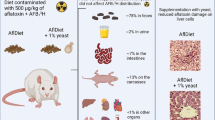Abstract
This study was designed to study the possible interrelationships between Torula yeast, vitamin E, and the dietary fat source on aflatoxin-induced tumors. Rats were fed Torula yeast-containing basal diets which included 1.7 ppm aflatoxin B1 with either lard, corn oil or no fat, and with or without vitamin E supplements for 3 months. Thereafter, the respective diets without aflatoxin were fed for ca. 9 months. Animals receiving the vitamin E-deficient diets had a high mortality. Although the vitamin E-deficient, aflatoxin-treated rats had lower wt gains than did the vitamin E-deficient controls, they lived twice as long. In addition, regardless of the dietary fat source, the kidneys and adrenals of these vitamin E-deficient, aflatoxin-supplemented rats were found to be significantly heavier than the controls, and plasma cholesterol levels were elevated. Increased amounts of liver lipid were observed in response to aflatoxin in both corn oil-fed and fat-deficient rats. No such differences were observed in the responses of the vitamin E-supplemented groups to aflatoxin. On the corn oil diet, aflatoxin administration resulted in an increased deposition of polyunsaturated fatty acids in cholesteryl ester and phospholipid fractions in livers of vitamin E-deficient rats and the phospholipid fraction of vitamin E-sufficient rats. The vitamin E-deficient rats exhibited necrosis of the liver, which was alleviated when aflatoxin was included in the diet, and calcification of the kidneys, which was potentiated by the dietary aflatoxin. No tumors were observed in these animals. In animals maintained on vitamin E-sufficient diets for 1 year, growth was depressed as a result of aflatoxin administration with the greatest depression occurring in the group fed corn oil. Spleen wt were decreased in all groups given aflatoxin. However, there were no changes in either plasma or liver cholesterol or total liver lipids which could be attributed to aflatoxin administration. When aflatoxin was fed with lard, the cholesteryl ester, triglyceride, and free fatty acid fractions of plasma had decreased amounts of the C20:4 acid. In the cholesteryl ester fraction only, this change was accompanied by increased levels of C16:0, C18:0, and C18:1 acids. In the liver phospholipids, there were increased levels of mono- and polyunsaturated fatty acids and decreases in the saturated fatty acids. All of the animals receiving aflatoxin exhibited severe necrosis and tumor formation in the kidneys; the animals fed lard had the highest level of involvement and those in the fat-free group the least. Liver pathology was the least marked among the rats fed the fat-free diet. Since aflatoxin-induced tumors are rich in lipids, the fat-free diet may be protective to the animal.
Similar content being viewed by others
References
Smith, J.W., and P.B. Hamilton, Poultry Sci. 49:207 (1970).
Sisk, D.B., and W.W. Carlton, Amer. J. Vet. Res. 33:107 (1972).
Wogan, G.N., and P.M. Newberne, Cancer Res. 27:2370 (1967).
Halver, J.E., in “Aflatoxin,” Edited by L.A. Goldblatt, Academic Press, New York, N.Y., 1969, pp. 265–306.
Carnaghan, R.B.A., Nature 208:308 (1965).
Amla, I., C.S. Kamala, G.S. Gopalakrishna, A.P. Jayaraj, V. Sreenivasamurthy, and H.A.B. Parpia, Amer. J. Clin. Nutr. 24:609 (1971).
Shank, R.C., C.H., Bourgeois, N. Keschamras, and P. Chandavimol, Food Cosmet. Toxic. 9:501 (1971).
Newberne, P., A. Rogers, and G.N. Wogan, J. Nutr. 94:331 (1968).
Newberne, P., D.H. Harrington, and G.N. Wogan, Lab. Invest. 15:962 (1966).
McLean, A.E.M., and E.K. McClean, Proc. Nutr. Soc. 26:XIII (1967).
Todd, G.C., W.I. Shalkop, K.L. Dooley, H.G. Wiseman, Amer. J. Vet. Res. 29:1855 (1968).
Schwarz, K., Proc. Soc. Exp. Biol. Med. 77:818 (1951).
Dicks-Bushnell, M.W., R.L. Andrews, and N.L. Langhrey, Can. J. Biochem. 46:1023 (1968).
Food and Agriculture Organization, in “Amino Acid Content of Foods,” Food Policy and Food Science Service, Nutrition Division, United Nations Food and Agriculture Organization, New York, N.Y., 1972.
Schwarz, K., Vitamins and Hormones 20:463 (1962).
Alfin-Slater, R.B., L. Aftergood, P. Wells, and D. Melnick, JAOCS 49:306A (1972).
Wesson, L.G., Science 75:339 (1932).
Aftergood, L., H.J. Hernandez, and R.B. Alfin-Slater, J. Lipid Res. 9:447 (1968).
Alfin-Slater, R.B., L. Aftergood, P. Wells, and D. Melnick, Federation Proc. 31:733A (1972).
Author information
Authors and Affiliations
About this article
Cite this article
Wells, P., Aftergood, L., Parkin, L. et al. Effect of dietary fat upon aflatoxicosis in rats fed torula yeast containing diet. J Am Oil Chem Soc 52, 139–143 (1975). https://doi.org/10.1007/BF02557944
Received:
Issue Date:
DOI: https://doi.org/10.1007/BF02557944




